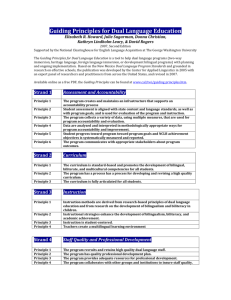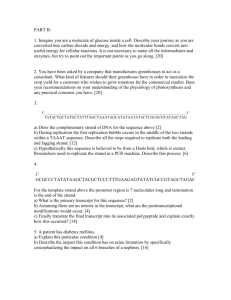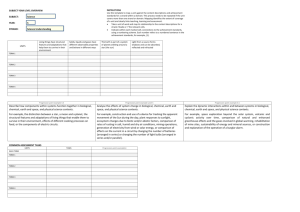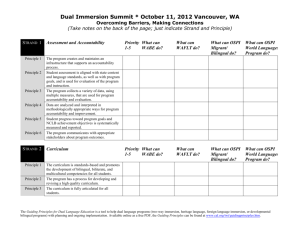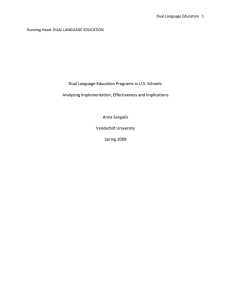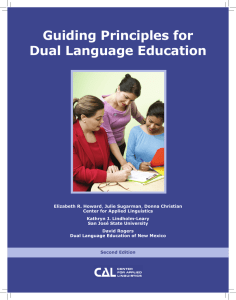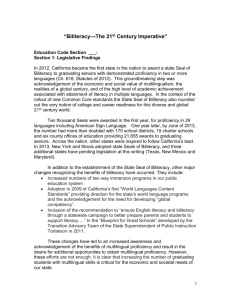a two-page summary of the strands and principles
advertisement
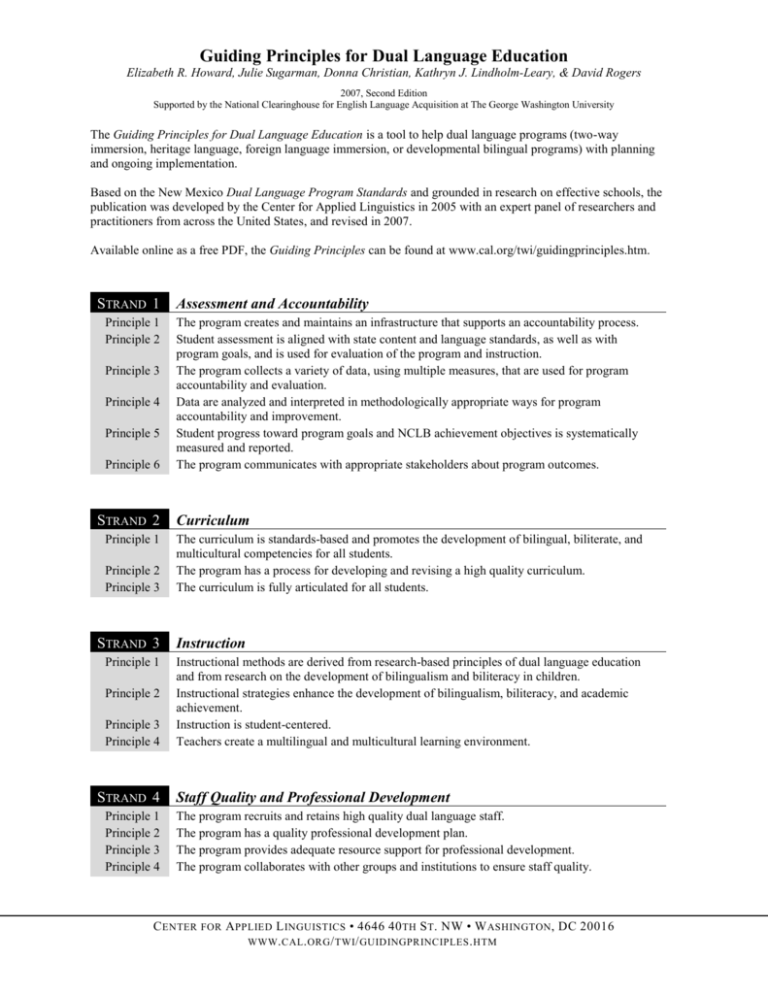
Guiding Principles for Dual Language Education Elizabeth R. Howard, Julie Sugarman, Donna Christian, Kathryn J. Lindholm-Leary, & David Rogers 2007, Second Edition Supported by the National Clearinghouse for English Language Acquisition at The George Washington University The Guiding Principles for Dual Language Education is a tool to help dual language programs (two-way immersion, heritage language, foreign language immersion, or developmental bilingual programs) with planning and ongoing implementation. Based on the New Mexico Dual Language Program Standards and grounded in research on effective schools, the publication was developed by the Center for Applied Linguistics in 2005 with an expert panel of researchers and practitioners from across the United States, and revised in 2007. Available online as a free PDF, the Guiding Principles can be found at www.cal.org/twi/guidingprinciples.htm. STRAND 1 Principle 1 Principle 2 Principle 3 Principle 4 Principle 5 Principle 6 STRAND 2 Principle 1 Principle 2 Principle 3 STRAND 3 Principle 1 Principle 2 Principle 3 Principle 4 STRAND 4 Principle 1 Principle 2 Principle 3 Principle 4 Assessment and Accountability The program creates and maintains an infrastructure that supports an accountability process. Student assessment is aligned with state content and language standards, as well as with program goals, and is used for evaluation of the program and instruction. The program collects a variety of data, using multiple measures, that are used for program accountability and evaluation. Data are analyzed and interpreted in methodologically appropriate ways for program accountability and improvement. Student progress toward program goals and NCLB achievement objectives is systematically measured and reported. The program communicates with appropriate stakeholders about program outcomes. Curriculum The curriculum is standards-based and promotes the development of bilingual, biliterate, and multicultural competencies for all students. The program has a process for developing and revising a high quality curriculum. The curriculum is fully articulated for all students. Instruction Instructional methods are derived from research-based principles of dual language education and from research on the development of bilingualism and biliteracy in children. Instructional strategies enhance the development of bilingualism, biliteracy, and academic achievement. Instruction is student-centered. Teachers create a multilingual and multicultural learning environment. Staff Quality and Professional Development The program recruits and retains high quality dual language staff. The program has a quality professional development plan. The program provides adequate resource support for professional development. The program collaborates with other groups and institutions to ensure staff quality. C ENTER FOR A PPLIED L INGUISTICS • 4646 40 TH S T . NW • W ASHINGTON , DC 20016 WWW . CAL . ORG / TWI / GUIDINGPRINCIPLES . HTM Guiding Principles for Dual Language Education STRAND 5 Principle 1 Principle 2 Principle 3 Principle 4 Principle 5 STRAND 6 Principle 1 Principle 2 Principle 3 STRAND 7 Principle 1 Principle 2 Principle 3 Principle 4 Principle 5 Program Structure All aspects of the program work together to achieve the goals of additive bilingualism, biliteracy and cross-cultural competence while meeting grade-level academic expectations. The program ensures equity for all groups. The program has strong, effective, and knowledgeable leadership. The program has used a well-defined, inclusive, and defensible process to select and refine a model design. An effective process exists for continual program planning, implementation, and evaluation. Family and Community The program has a responsive infrastructure for positive, active, and ongoing relations with students’ families and the community. The program has parent education and support services that are reflective of the bilingual and multicultural goals of the program. The program views and involves parents and community members as strategic partners. Support and Resources The program is supported by all program and school staff. The program is supported by families and the community. The program is adequately funded. The program advocates for support. Resources are distributed equitably within the program, school, and district. C ENTER FOR A PPLIED L INGUISTICS • 4646 40 TH S T . NW • W ASHINGTON , DC 20016 WWW . CAL . ORG / TWI / GUIDINGPRINCIPLES . HTM
